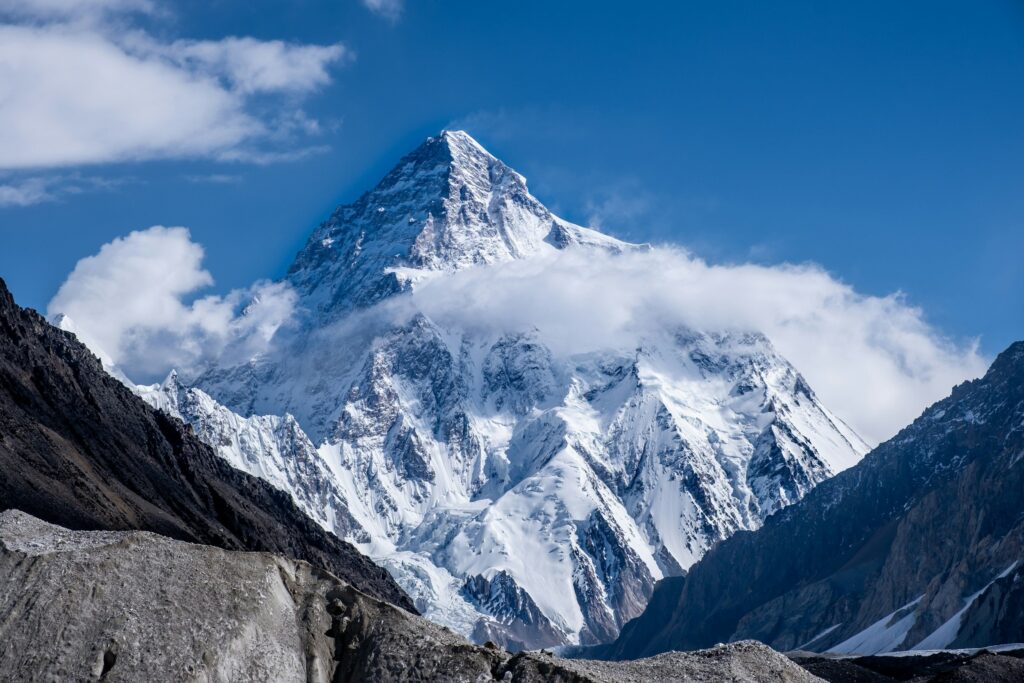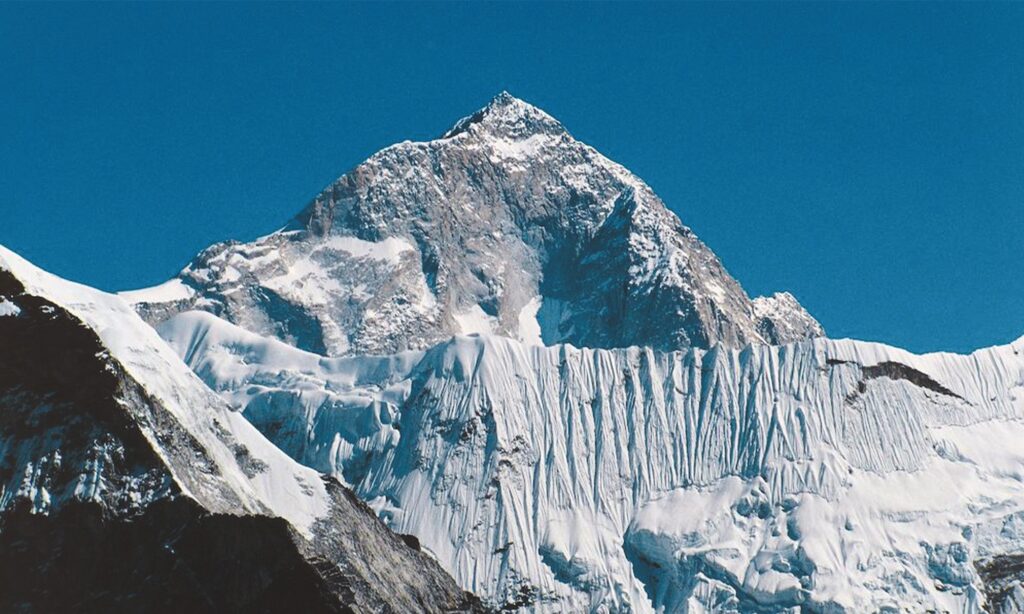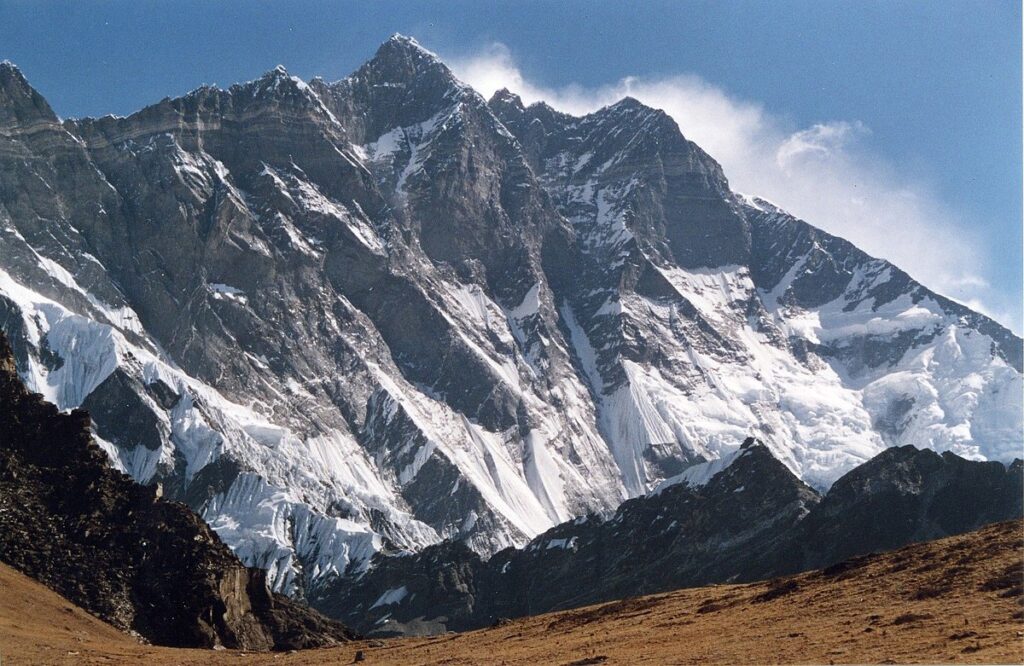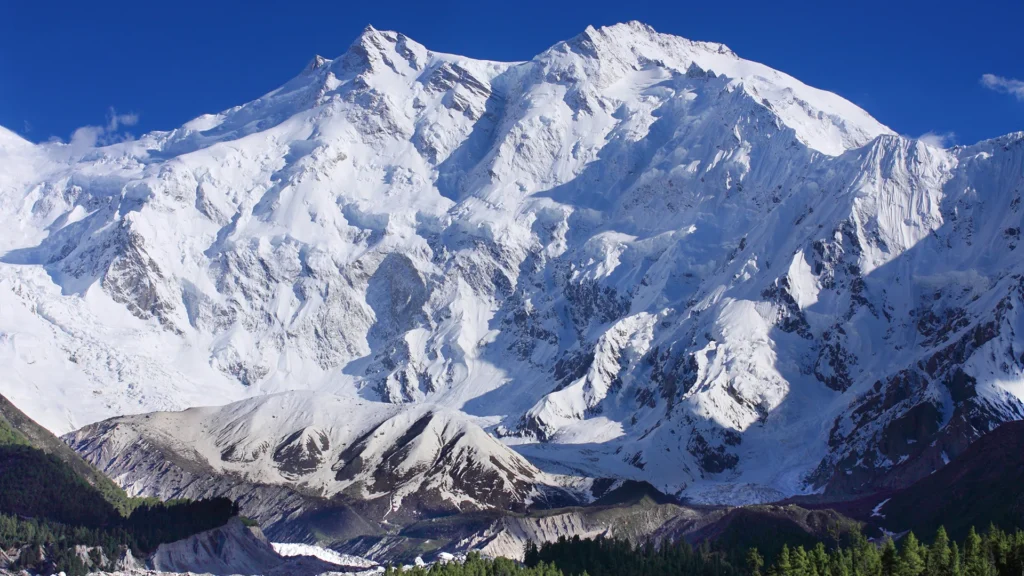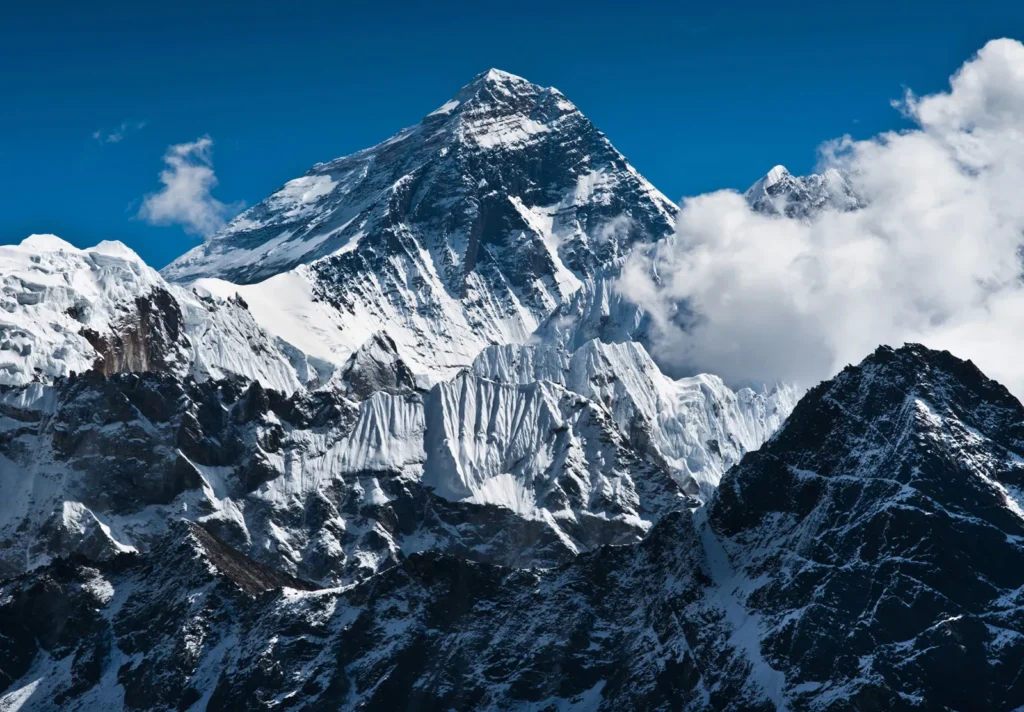Mountains range is one of the most famous in the world. The Himalayas stretch across five countries are Nepal, India, Bhutan, China, and Pakistan. They are home to the tallest mountains on Earth, including Mount Everest, the highest of all. But the Himalayas are not just about big mountains. They are also spiritual places, full of wildlife, beautiful nature, and old cultures. Many people around the world visit them for adventure, peace, or religious reasons.
In this blog, we will look 10 highest mountains in Himalayas and learn about them.
Mount Everest is the tallest mountain in the world. It stands at 8,848.86 meters (29,031.7 feet) high. It lies in Nepal. Nepalese call it Sagarmatha and Tibetans call it Chomolungma. Many climbers from around the world dream of reaching the top. It was first climbed in 1953 by Sir Edmund Hillary from New Zealand and Tenzing Norgay, a Sherpa from Nepal. Climbing Everest is difficult because of its high altitude, freezing temperatures, and thin air. Even though many people have climbed it, it can still be dangerous. Every year, climbers face strong winds, avalanches, and altitude sickness. Everest is also a sacred mountain in many cultures and attracts both adventurers and spiritual seekers. It remains the most famous mountain in the world.
Best season for Mount Everest:
Pre-Monsoon (Spring) – Late April to May
Pros:
Post- Monsoon (Autumn) – Late September to October
Pros:
1.Stuning visibility and fewer crowds
Seasons to Avoid:
Highlights of Mount Everest :
2. K2 (8,611 m)
K2 is the second-highest mountain in the Himalayas, standing at 8,611 meters (28,251 feet). It is part of the Karakoram Range, which is near the Himalayas. K2 lies on the border between Pakistan and China. It is often called the “Savage Mountain” because it is very dangerous to climb. The weather is harsh, the path is steep, and there is no easy route to the top. It was first climbed in 1954 by Lino Lacedelli and Achille Compagnoni from Italy. K2 has a higher death rate than Everest, and few people attempt it compared to other tall peaks. There are no support facilities like in Everest, which makes it even harder. Despite the danger, it is known for its beautiful pyramid shape and attracts experience mountaineers from all over the world.
Highlights of K2:
Best Season to climb or visits:
Best Climbing Season: Late June to August
3. Kangchenjunga (8,586 m)
Kangchenjunga is the third-highest mountain in the world at 8,586 meters (28,169 feet). It is located on the border of Nepal and India, in the eastern Himalayas. The name means “Five Treasures of Snow,” because the mountain has five main peaks. It was once thought to be the tallest mountain until more accurate measurements proved Everest is higher. The first successful climb was in 1955 by Joe Brown and George Band from the UK. Local people believe Kangchenjunga is a sacred mountain, and most climbers stop a few meters from the summit out of respect. The mountain is known for its stunning beauty and remote location. It has glaciers, deep valleys, and rich wildlife around it. Due to the tough terrain and fewer visitors, Kangchenjunga remains one of the more peaceful and mysterious peaks in the Himalayas.
Highlights of Kangchenjunga:
Best season to Visits and Climb:
Spring (Mid-March to May) to visit or trek
Best Season to climb Kangchenjunga
Spring (April to May)
Season to avoid
Monsoon (June to early September)
4. Lhotse (8,516 m)
Lhotse is the fourth- highest mountains in the Himalayas, standing at 8,516 meters (27,940 feet). It is located right next to Mount Everest on the Nepal and Tibet border and shares the same route as Everest up to Camp 3. Lhotse was first climbed in 1956 by Fritz Luchsinger and Ernst Reiss from Switzerland. While it is often overshadowed by Everest, Lhotse is a very impressive mountain in its own right. It has one of the steepest and most dramatic mountain faces in the world. The Lhotse South Face, which rises over 3,000 meters almost straight up. That wall is a big challenge even for skilled climbers. Lhotse is less crowded than Everest, making it a great choice for those who want a serious climb without the large numbers of tourists. It is beautiful, bold, and often forgotten.
Highlights of Lhotse
Best Season to climb and Trek
1.Pre- Monsoon (Spring) – April to May
2. Post- Monsoon (Autumn)- Late September to Early November
Season to Avoid:
5. Makalu (8,485 m)
Makalu is the fifth-Highest mountains in the Himalayas at 8,485 meters (27,838 feet). It also lies on the Nepal–Tibet border, not far from Mount Everest. The mountain was first climbed in 1955 by Jean Couzy and Lionel Terray of a French expedition. Makalu is known for its unique pyramid shape, with four sharp ridges and steep faces. It is one of the most difficult 8,000-meter peaks to climb because of its steep slopes and sharp ridgelines. Weather and strong winds also make it challenging. Unlike Everest, there are fewer climbers and no crowds. That means climbers must be highly skilled and independent. The area around Makalu is also very beautiful and less visited. It includes the Makalu-Barun National Park, which has rare plants, animals, and deep forests. For mountaineers looking for adventure and solitude, Makalu offers both.
Highlights of Makalu:
Best Season to Climb Makalu
Spring Season ( Pre-Monsoon): Mid- April to Late May
Autumn Season ( Post – Monsoon) : Late September to Early November
Season to Avoid:
6. Cho Oyu (8,188 m)
Cho Oyu is the sixth-highest mountain in the world, with a height of 8,188 meters (26,864 feet). It is located on the border between Nepal and Tibet, close to Mount Everest. The name Cho Oyu means “Turquoise Goddess” in Tibetan. It was first climbed in 1954 by Herbert Tichy, Joseph Jöchler, and Pasang Dawa Lama. Among all the 8,000-meter peaks, Cho Oyu is often consider the easiest to climb, which is why many mountaineers choose it as their first big mountain. It has fewer technical challenges and more gentle slopes compared to other tall peaks. Because of this, it is very popular with climbers who want to experience high-altitude climbing in a safer way. The views from the summit are breathtaking, showing Everest and other nearby mountains. Cho Oyu is also use as a training climb for those preparing for Everest.
Highlights of Cho Oyu:
Best Season to Climb and visit
Spring season ( Pre-Monsoon): Late April to Late May
Autumn Season ( Post – Monsoon) : Late September to Mid-October
Season to avoid:
7. Dhaulagiri (8,167 m)
Dhaulagiri I is the seventh-Highest mountains in the Himalayas at 8,167 meters (26,795 feet). It is located in western Nepal and is the highest mountain that lies completely within one country. The name Dhaulagiri comes from Sanskrit, meaning “White Mountain.” It was first climbed in 1960 by a Swiss-Austrian-Nepali team. Dhaulagiri is known for its steep, icy slopes, and for being one of the most beautiful mountains in Nepal. It rises sharply from the surrounding land, also creating dramatic scenery. Near Dhaulagiri is the Kali Gandaki Gorge, one of the world’s deepest. Although fewer people climb Dhaulagiri compared to Everest or Manaslu, it is still a popular peak among experienced mountaineers. Weather and avalanches can be dangerous, so it requires careful planning. Trekking in the Dhaulagiri region is also a special experience, offering peaceful trails and close views of high peaks.
Highlights of Dhaulagiri:
Best Season to climb and visits
2. Autumn ( Late September to Early November) – Excellent time
Season to avoid:
2. Winter (Late November to February)
8. Manaslu (8,163 m)
Manaslu is the 8th highest mountain in the world and part of the Himalayan mountain range. It stands at 8,163 meters (26,781 feet) high and is located in Nepal. The name “Manaslu” means “Mountain of the Spirit” in Sanskrit. It was first climbed in 1956 by a Japanese team. Compared to Mount Everest, Manaslu is less crowded, but it is still very dangerous due to avalanches and rough weather. The mountain is popular among experienced climbers who want to challenge themselves. It is surround by beautiful scenery, including glaciers, deep valleys, and remote villages. Manaslu is also part of a protected area in Nepal, home to rare animals and plants. Many trekkers enjoy the Manaslu Circuit trek nearby.
Highlights of Manaslu:
Best Season to Climb and Trek
For Trekking:
Spring (march to May)
Autumn (late September to early December)
For climbing
Spring (late April to early June)
Autumn( late Sept to early Nov)
Season to Avoid:
Monsoon (June to early Sept)
Winter (late Dec to feb):
9. Nanga Parbat (8,126 m)
Nanga Parbat is the ninth-highest mountain in the world, rising to 8,126 meters (26,660 feet). It is located in Pakistan, and its name means “Naked Mountain” in Urdu. It is also known as the “Killer Mountain” because many climbers died while trying to reach its summit in the early days of exploration. The first successful ascent was in 1953 by Hermann Buhl from Austria, who made the climb solo, without oxygen—a rare and brave achievement. Nanga Parbat is known for its massive, dramatic face called the Rupal Face, which is one of the tallest mountain walls in the world. The mountain is extremely dangerous due to its steep sides, avalanches, and unpredictable weather. Because of this, it is mostly attempted by expert climbers. Despite its dangers, Nanga Parbat remains one of the most beautiful and mysterious peaks in the Himalayas.
Highlights of Nanga Parbat:
Best Season to Climb and Trek
For Trekking:
Late Spring to Early Autumn
For climbing:
Summer (June to August) and Winter (Dec to Feb)
Season to Avoid:
June to Early September (Monsoon Season)
Late November to March (Winter):
10. Annapurna I (8,091 m)
Annapurna I is the tenth-Highest mountains in the Himalayas at 8,091 meters (26,545 feet). It is lies in central Nepal and was the first 8,000-meter mountain ever climbed, in 1950, by Maurice Herzog and Louis Lachenal of France. The name “Annapurna” comes from the Sanskrit words meaning “Goddess of Food” or “Full of Nourishment.” Annapurna I is part of the larger Annapurna Massif, which includes many high peaks. Although it’s not the tallest, Annapurna I has one of the highest death rates among all 8,000-meter peaks. This is because of its dangerous avalanches and tough weather conditions. Even experienced climbers must be very careful. However, the Annapurna region is also home to some of Nepal’s most famous treks, like the Annapurna Circuit and Annapurna Base Camp Trek, which attract thousands of trekkers each year. The area is rich in natural beauty and culture.
Highlights of Annapurna I:
Best Season to Climb and Trek
For trekking
Spring (March to May)
– Warm weather, blooming rhododendrons
Autumn (Late Sept to early Dec)
– Stable weather, clear skies
For climbing
Spring (Late April to Early June)
– Best summit windows, more stable snow
Autumn (Late Sept to Early Nov)
– Quieter, but colder
Season to Avoid:
June to Early Sept (Monsoon)
Late Nov to March (Winter)
• Extremely dangerous avalanche zones
• Poor visibility, unstable snowpack
• Winter storms, extreme cold, also frostbite risk
• High winds & also deadly exposure on summit ridges
Some pictures of Mountains
